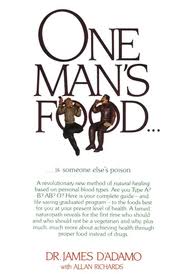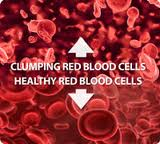One Man’s Food . . . is someone else’s poison
 Dr. James D’Adamo, after graduating from Naturopathic Medical school, studied at some of the great spas in Europe. He noticed that although many patients did well on the strict vegetarian and low-fat diets there, some did not improve, in fact, did poorly or worsened. It got him searching for a blueprint that would determine the different dietary needs of patients.
Dr. James D’Adamo, after graduating from Naturopathic Medical school, studied at some of the great spas in Europe. He noticed that although many patients did well on the strict vegetarian and low-fat diets there, some did not improve, in fact, did poorly or worsened. It got him searching for a blueprint that would determine the different dietary needs of patients.
 Since blood is the fundamental source of nourishment of the body, he started looking there. Over many years with countless patients, a pattern started to become clear with blood type. He used a blood type diet in his clinic in Brooklyn, New York. Then he published One Man’s Food . . . is someone else’s poison in 1980 detailing his blood type diets and clinical results.
Since blood is the fundamental source of nourishment of the body, he started looking there. Over many years with countless patients, a pattern started to become clear with blood type. He used a blood type diet in his clinic in Brooklyn, New York. Then he published One Man’s Food . . . is someone else’s poison in 1980 detailing his blood type diets and clinical results.
Dr. James D’Adamo’s son, Peter, was in Naturopathic Medical school at that time. Since the school emphasized scientific research he did a literature search. He easily found an association of type O and peptic ulcers and type A and stomach cancer and pernicious anemia to start. The link that he was looking for was in that type O people do well on animal protein, which needs more stomach acid for proper digestion. And peptic ulcer is relate to higher than normal stomach acid. Similarly, pernicious anemia is related to a lack of vitamin B12, which needs sufficient stomach acid to be absorbed. In addition, stomach cancer was often linked to low stomach acid. And blood type A individuals are predisposed to illnesses associated with too little stomach acid.
Under Dr. Peter D’Adamo‘s tireless research and clinical correlations, blood type analysis became a powerful means of interpreting individual variations in health and disease. Dr. D’Adamo has tested virtually all common foods for blood type reactions, using both clinical and laboratory methods to establish this interpretation.
This Explains It
 Why is one person perfectly healthy while everyone else around is coming down with the latest cold or flu? The healthy person’s blood type is not susceptible to those particular invaders.
Why is one person perfectly healthy while everyone else around is coming down with the latest cold or flu? The healthy person’s blood type is not susceptible to those particular invaders.
Susceptibility, or lack of resistance, is the basic issue of most diseases. Many microbes have the ability to mimic signaling markers that are considered friendly by the immune system of a particular blood type. These microbes then are not recognized as invaders by the immune system and gain entry to the body. Once in the system, they quickly overwhelm it and take control.
But it is not always that simple. There are other factors, such as lifestyle issues like stress and smoking.
Your blood type is a key to your body’s immune system
 Following the blood type diet can restore natural protective functions of your immune system.
Following the blood type diet can restore natural protective functions of your immune system.
A chemical reaction occurs between your blood and the foods you eat. It is based on the lectins that are present in food and in your body. Lectins are abundant in nature They are diverse proteins found in plants, a kind of primitive immune system. Fewer of them are found in animals, but they are also significant.
Lectins act as glues. When plant lectins bind to an animal cells, they clump together. The lectins are highly specific to the kind of cell they will adhere to.
Lectins are how organisms attach themselves to other organisms in nature. For example, bacteria and other microbes have lectins like suction cups on their surface, to attach to the slippery mucous lining of the digestive, respiratory, urinary tracts. Then they can stick around and multiply, causing you an infection.
As another example, cells in our own liver’s bile duct use lectins to snatch up bacteria and parasites to destroy them and not allow them to create an infection.
How Lectins Act in Your Body
 Lectins in food either are similar to, or different from those in your body. Since they are highly specific, they target specific organs or body systems. When they are incompatible, they go to that organ or body system and agglutinate (clump) the blood cells in that area
Lectins in food either are similar to, or different from those in your body. Since they are highly specific, they target specific organs or body systems. When they are incompatible, they go to that organ or body system and agglutinate (clump) the blood cells in that area
Many food lectins have characteristics that cause bad reactions in certain blood types. For example, milk lectins, when drunk by a person with blood type B, immediately start the agglutination process in order to gather them together to get rid of them. They are targeted for destruction as foreign invaders by the immune system.
- In the digestive system, they create violent inflammation of the sensitive mucous of the intestines that can mimic food allergies and also cause irritable bowel in the intestines
- In the nervous system, nerve cells are very sensitive to the agglutinating effect of food lectins.
- In joints, clumped lectins can lead to arthritis that is indistinguishable from rheumatoid arthritis.
- Clumping from lectins can even cause cirrhosis in the liver, or block blood flow through the kidneys.
- White blood cells are stimulated by food lectins to multiply rapidly. They do not clump blood, but the immune system is overstimulated.
For the most part, our immune system protects us from lectins: 95% are sloughed off. However, 5% of the lectins we eat are filtered into the bloodstream, where they can react with and destroy red and white blood cells.
Learn more next week when I talk about Eating Right for Your Type.
WANT TO USE THIS ARTICLE IN YOUR NEWSLETTER OR WEB SITE?
You can, as long as you include this complete blurb with it: “Naturopathic Physician Dr. Cheryl Kasdorf is a doctor who listens and has answers with a natural approach that works. She is known as the go-to person to get back your get-up-and-go when it is gone, gone, gone. Get your FREE gift “Dr. Kasdorf’s Health Secrets for Feeling & Looking Great” at drcherylkasdorf.com



